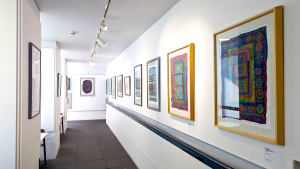By Blue Summer
‘Accessibility’ as a word is easy to define. The OED (2021) defines it as ‘The quality or condition of being accessible (in various senses)’. However, when discussing the concept of accessibility – the wider meaning – it becomes far more complex. In this context, accessibility refers to the ability of a disabled person to do a task, engage with media, etc., in the same length of time, or with the same level of interaction, as a nondisabled person. To discuss whether something is accessible or not is to discuss whether it can be used and engaged with by all people.
This, however, is also where the issues arise, because what makes a given thing accessible for one person may make it inaccessible for another. A classic example would be that for people with low vision, having a piece of art displayed with bright lighting would make it more accessible. However, that lighting would make the art display inaccessible to someone with photosensitivity. It is simply impossible to make anything accessible to everyone. Accessibility, then, becomes about maximising access, rather than achieving an impossible complete or perfect level of access.
The principles of Universal Design are a very good starting place to try and maximise accessibility. There are seven principles, and a further definition put forward in the Disability Act 2005, but what it boils down to is a focus on simplicity, flexibility, and trying your best to create integral accessibility – accessibility that is built in, not an afterthought. Within the digital sphere, there are international standards for website accessibility to ensure that coding allows, for example, for a website to be accurately and effectively navigated using a screen reader. This means that the digital sphere can often lend itself towards accessibility being integral, and in some ways online content has a level of inherent accessibility. For example, online content overcomes geographical limitations, plus physical accessibility limitations. Online content can also easily be made changeable – the text can be made bigger or smaller, different colours or different backgrounds, or can be read out by a screen reader.
During the Covid-19 pandemic lockdowns, online content became increasingly common and widespread as it swiftly became the only way for people and institutions to reach their audiences. What followed was a period of ingenuity where, in quite a short timeframe, services and events that previously had only ever existed in a face-to-face, physical capacity were interpreted into the digital world. This had the accidental additional effect of increasing accessibility in many areas – online lectures made education more accessible to many disabled students, working from home increased accessibility for disabled employees, and online exhibitions and events made culture more accessible to many. While the increase in accessibility was a good thing, it also raised the question of why these things hadn’t been done or made available before.
At Attenborough Arts Centre a concerted effort was made to continue to connect to audiences throughout the pandemic. Projects were undertaken to encourage people to be creative during lockdowns and to connect with those people who were isolated and might feel alone. Post-pandemic, the digital endeavours of Attenborough Arts Centre have taken a backseat, with many feeling that the way we can best connect to audiences and pursue our goals is through face-to-face, physical projects. Nonetheless, there are some online projects and content that continue to offer digital accessibility at Attenborough Arts Centre, and those are what will be explored and celebrated in this article.

Padlet for the Alan Caine exhibition
Alan Caine was an artist who, alongside Eleanor Hartley and Sir Richard Attenborough, founded the ‘Attenborough Centre for Disability and the Arts’, which would later become Attenborough Arts Centre. Caine passed away in 2022 and the Alan Caine exhibition, displayed from 31 March to 11 June 2023 in the Balcony Gallery, seeks to celebrate his artistic practice as well as honour his place in the centre’s history. As part of this exhibition, a Padlet has been created where visitors are encouraged to ‘add your memories of Alan; what Attenborough Arts Centre means to you; or any photos of the centre’. This virtual gallery of sorts not only adds an element of interaction to the exhibition, but also means that those who cannot attend the exhibition in-person can still be involved on some level. This helps to overcome geographical and physical accessibility issues.
Padlets are not something that are created for all exhibitions at Attenborough Arts Centre, but maybe this is something that could be looked into as a method of increasing the accessibility of physical exhibitions that don’t have other online or digital aspects. Maximising accessibility will always be an ongoing process and effort, and one Attenborough Art Centre is committed to pursuing.
SENsory Atelier Digital Art Packs
SENsory Atelier is an ongoing project where Attenborough Arts Centre works with nine Special Educational Needs (SEN) schools in Leicester and Leicestershire, drawing upon Reggio Emilia principles to explore ‘new ways to learn, discover and develop together’. While the majority of the work this project undertakes is done face-to-face, the SENsory Atelier website offers downloadable digital art packs alongside video tutorials in order to support the delivery of creative and exploratory activities at home or in classrooms. This makes some of the work of the SENsory Atelier project accessible to people who are not connected with the nine schools directly involved, including to SEN children who may not be able to attend a school in-person.
Nurture Network
The Nurture Network is related to the SENsory Atelier project, providing an online network for artists to connect and discuss Special Educational Needs and Disabilities within art. Bi-monthly online meetings are held, each of which include mindfulness exercises, an open and honest guest speaker, discussions, and space for networking and sharing work. There’s also a Padlet where resources can be shared, and discussions can be continued beyond the meetings. The format of the network makes it highly accessible, allowing participation regardless of physical needs. The meetings have a strict time limit, increasing the accessibility of the network to various neurodiversities and potentially to those for whom sitting still for extended periods is physically difficult. The online venue overcomes geographic limits, and the network provides an excellent opportunity for artists of all backgrounds to come together in a way that might not otherwise be possible.
Limbik Theatre presents All the Water in the World
A performance recently hosted by Attenborough Arts Centre was ‘All the Water in the World’ by Limbik Theatre. Performed entirely through WhatsApp, potential audiences could purchase a ticket for a one-hour, one-to-one experience delivered ‘using a combination of live calls, messaging, and 3D spatial audio’. A version accessible for visually impaired audiences was also available. The unique format of this piece of theatre makes it accessible in ways traditional theatre couldn’t be – it can be experienced fully from within your own home, and the audience member is guided through the performance individually. This potentially was part of the appeal – despite the unusual and unexpected method of delivery, tickets for the performance sold out.

Odds On by Dante or Die (137 words)
Odds On is an interactive short film, commissioned by The Lowry, which came to Attenborough Arts Centre as part of its digital tour. It examines the world of online gambling by making the viewer into the protagonist, and using a fusion of a live cast and animation to tell a story of seduction and compulsion. Once again, the online delivery of this film allows it to reach further and to overcome barriers that are inherent to physical formats. The entry into the film provides a trigger warning for gambling, an important presence for increasing accessibility – those people for whom a trigger warning is necessary will have their accessibility hindered if those trigger warnings aren’t in place as they will never know what will or won’t be suitable for them, which then could lead to a general avoidance of everything.
Upcoming Digital Shows for Autumn 2023
Attenborough Arts Centre strives for the goal of accessibility being inbuilt in shows put on and productions hosted. As one of the principles of Universal Design, making accessibility integral to productions goes a long way towards maximising the accessibility potential. Further digital shows are likely to be included in future programmes as they are a wonderful way of furthering the reach and accessibility of the work. For example, in the upcoming Autumn 2023 programme, there are two potential digital productions being considered.
Gallery Learning Pack
The Gallery Learning Pack was developed to support the Tony Heaton exhibition ‘altered’. It offers further information about the artist and art, and allows for greater accessibility for groups in the gallery spaces. Aimed at a range of age groups and access requirements, the pack offers both information that would be helpful to individuals hoping to feel more confident in accessing the exhibition, and to teachers looking to plan out a class trip and all the access needs that might carry. A potential gallery visit session plan is included with a helpful level of detail, and a visual timetable going from ‘Get on the bus’ to ‘Goodbye’ is also provided.
This is something that drastically increases the level of accessibility by ensuring that visitors have a grounding in what they are going to experience, and also are aware of the physical access options and can plan a day with a significantly lower chance of unforeseen problems.
Throwback to Digital in Lockdown
As mentioned in the introduction, venues and institutions creating digital content went through a significant boom during the Covid-19 pandemic lockdowns, and Attenborough Arts Centre was no exception. A number of projects were created with the goal of fostering connection and creativity in a time where people felt isolated and restricted. An example of this were the Wildcard Wednesday boxes which people could sign up to receive. The boxes included craft materials such as clay or tissue paper, and each week there would be a video to guide people through that week’s craft project. The particular goal of these boxes was to reach those most isolated by the lockdown, such as Leicester’s significant international student population. The pandemic was a time where digital content came into its own, and was instrumental in helping people who otherwise would have been entirely alone. Even though the pandemic has now been declared over, there are still people for whom digital content is significantly more accessible, and they shouldn’t be forgotten.
Conclusion
It is as unavoidable as it is unfortunate that complete accessibility is, at this point in time, unachievable. However Attenborough Arts Centre does, I believe, make great efforts to make accessibility an underpinning principle of everything we do and offer. That having been said, I also believe that there is always room for improvement. Following the end of the lockdown portion of the pandemic, businesses started to reintroduce face-to-face and in-person events that had been online-only for so long. As time went on and it became clear that there wasn’t going to be any further lockdown measures, many businesses, Attenborough Arts Centre included, started winding back their online offerings in order to once again predominantly focus on the face-to-face. I believe, however, that this resulted in a step backwards for accessibility in many arenas.
As an example, prior to Covid-19 many disabled university students, myself included, had been asking for accommodations to include taking lectures and participating in seminars from home, and universities had fairly consistently said that this was impossible. Of course, during lockdowns, all education moved online and it became clear slightly later on that it was possible for classes to be held in a mixed-modality format with some students attending in-person, and others online. In 2023, we’re back to universities telling disabled students that that type of accommodation isn’t possible. This is a fairly stark example of digital content bringing greater accessibility and its removal doing the opposite, but the overarching premise stands firm – a lot of the accessibility advances that came about during the pandemic have since disappeared.
Attenborough Arts Centre does still offer digital content, including some wonderful productions and resources. But I think we could do better, go further, and remember how dramatically the inclusion of online and from-home options can improve accessibility for so many people.

